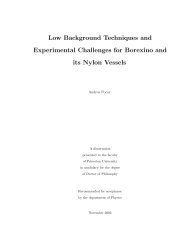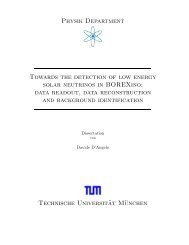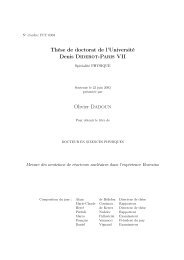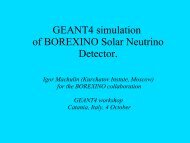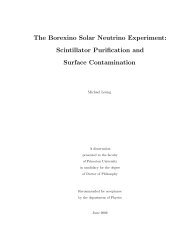Development of a Liquid Scintillator and of Data ... - Borexino - Infn
Development of a Liquid Scintillator and of Data ... - Borexino - Infn
Development of a Liquid Scintillator and of Data ... - Borexino - Infn
You also want an ePaper? Increase the reach of your titles
YUMPU automatically turns print PDFs into web optimized ePapers that Google loves.
5 Particle Identification with a Neural Network<br />
5.3.2 <strong>Data</strong> from CTF2<br />
I tested the neural network also with real CTF data to see if in the case <strong>of</strong> real, more noisy<br />
spectra the NN would be superior to the tail-to-total method. Not for all CTF2 runs flash ADC<br />
data are available. To have a sufficiently high statistics for the training <strong>of</strong> the net, I chose<br />
one <strong>of</strong> the source runs, run 793. In this run, all the Bi <strong>and</strong> Po events occurred at the same<br />
position, i.e. the center <strong>of</strong> the Inner Vessel. In this case, the pulse shape is not further broadened<br />
by the time <strong>of</strong> flight differences to the different PMTs, so that the pulse shape discrimination<br />
should yield better results than for r<strong>and</strong>omly distributed events. Fig. 5.9 shows a typical Bi<br />
beta <strong>and</strong> a Po alpha pulse.<br />
A total sample <strong>of</strong> 2360 events was available from run 793. The sample was too small to reduce<br />
it further by restricting the energy <strong>of</strong> the Bi events to the same energy range as the Po<br />
events, which would have been the case for only events. Giving the energy <strong>of</strong> the event<br />
as input parameter for the NN could lead to the unwanted case, that the NN uses the energy<br />
as decision criterium: high energy beta events, low energy alpha events. Hence I took as input<br />
parameter only the normalized flash ADC spectrum (100 bins = 250 ns). 1000 events were<br />
chosen as training set for the NN. The other 1360 events are the validation set.<br />
The training process continued 5000 epochs, until the error function became flat. The results<br />
<strong>of</strong> the NN algorithm are shown in fig. 5.10. From 680 beta events only 26 were misidentified<br />
as alpha events. From 680 alpha events 22 were misidentified as beta events. This means, that<br />
for 96.2 % beta identification efficiency, 96.7 % <strong>of</strong> the alpha events are rejected.<br />
For a comparison I tested the pulse shape discrimination using the tail-to-total ratio (with the<br />
tail starting after 48 ns) on the same data sample. For a beta identification efficiency <strong>of</strong> 96 %,<br />
an alpha rejection efficiency <strong>of</strong> 84.9 % is obtained (see fig. 5.11).<br />
In this case, the neural network is clearly better than the simple tail-to-total ratio. These results<br />
are encouraging for BOREXINO, but data samples with a higher statistics <strong>and</strong> further<br />
systematic tests are needed.<br />
72



